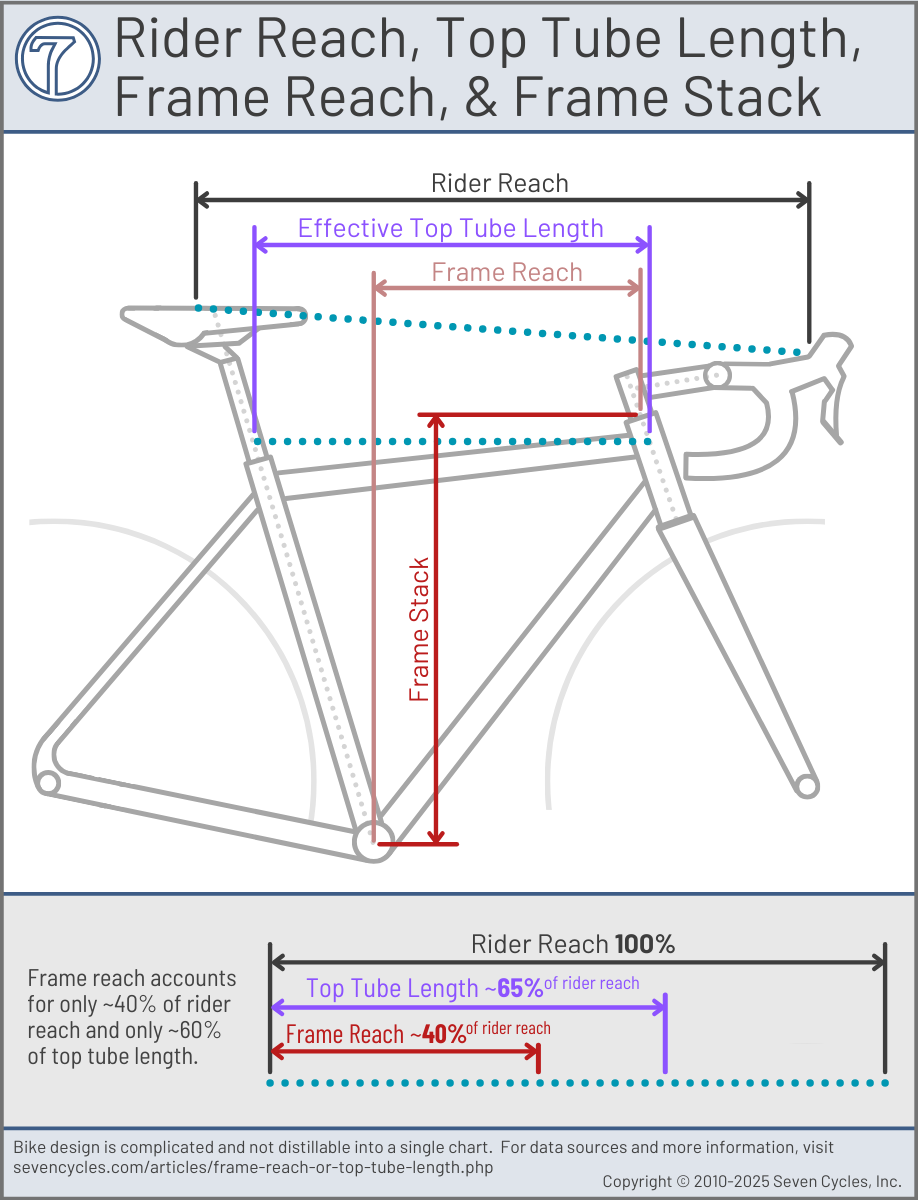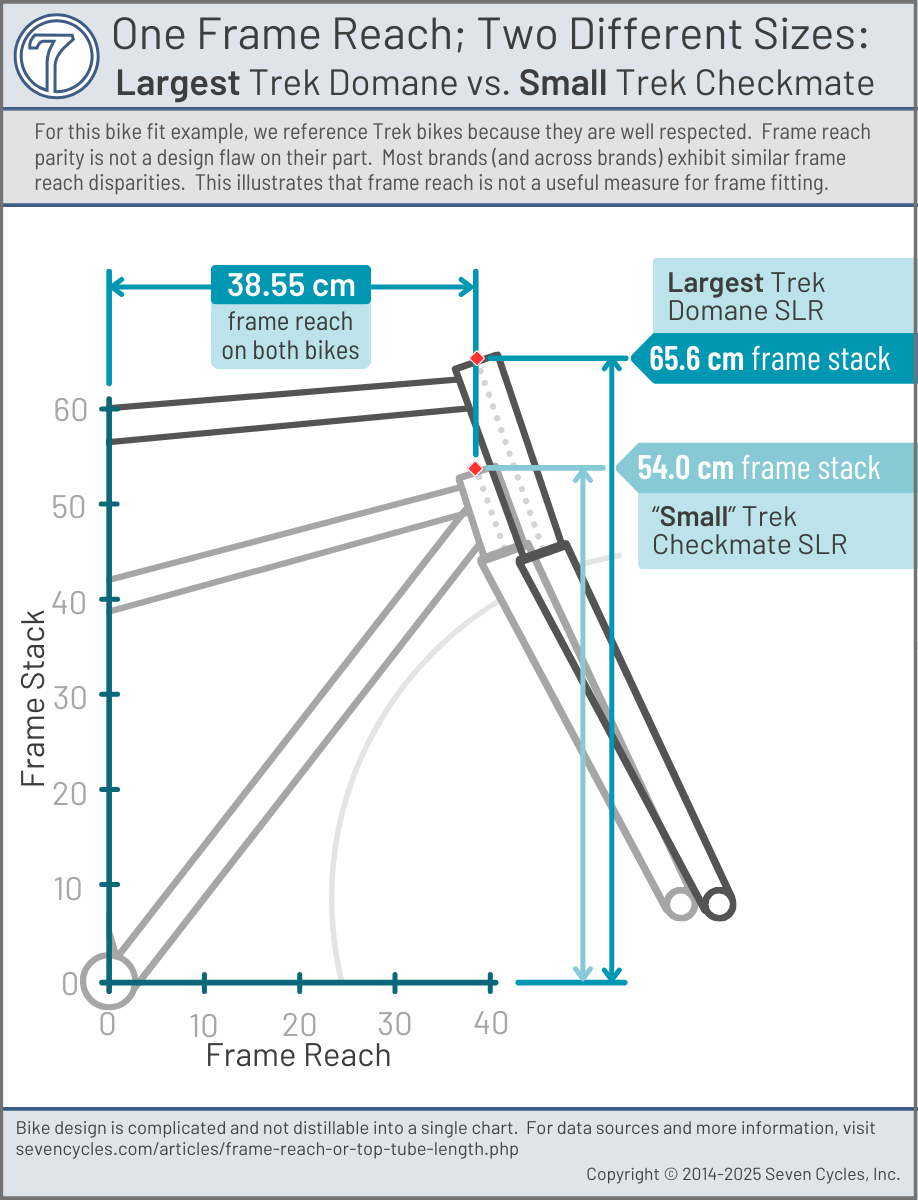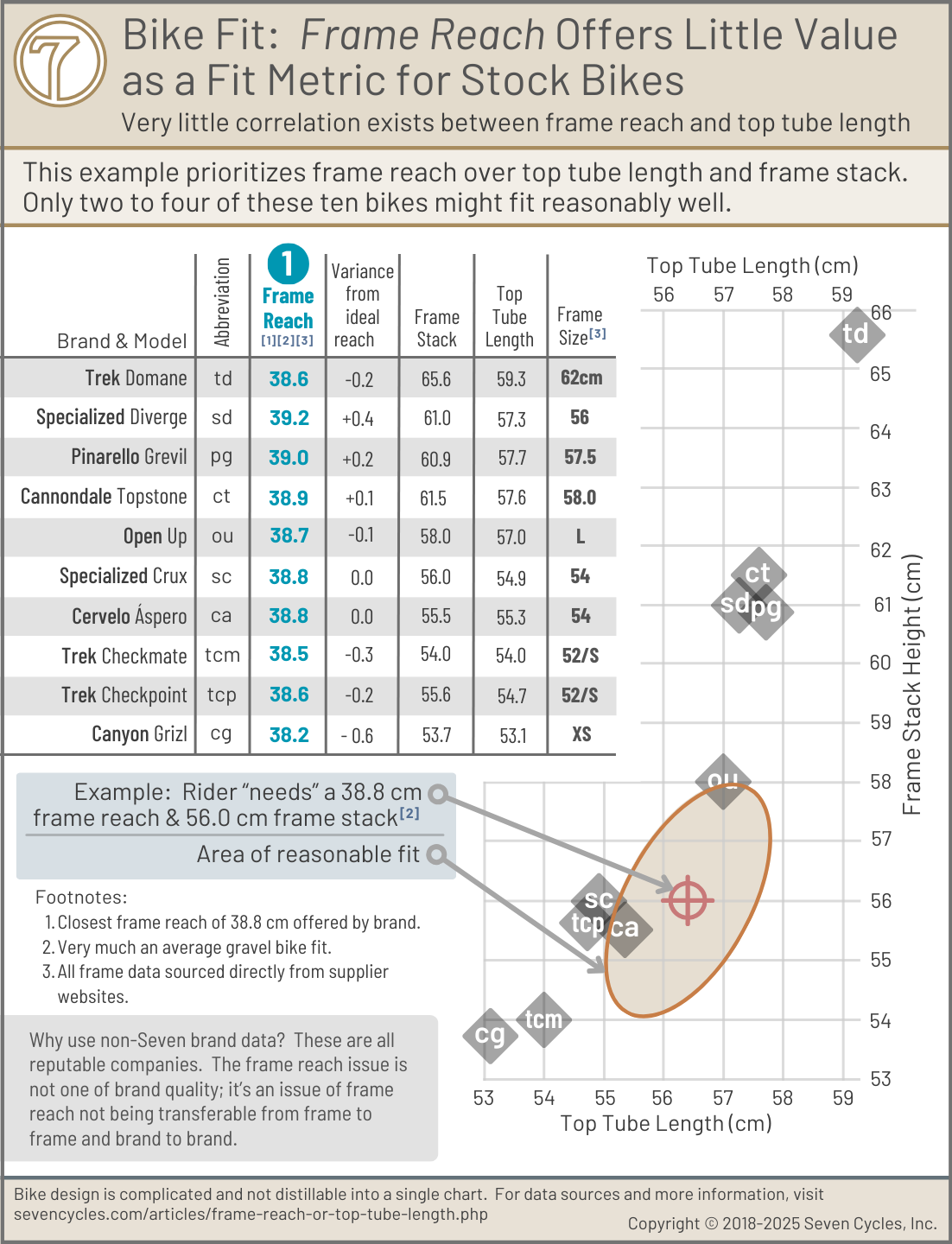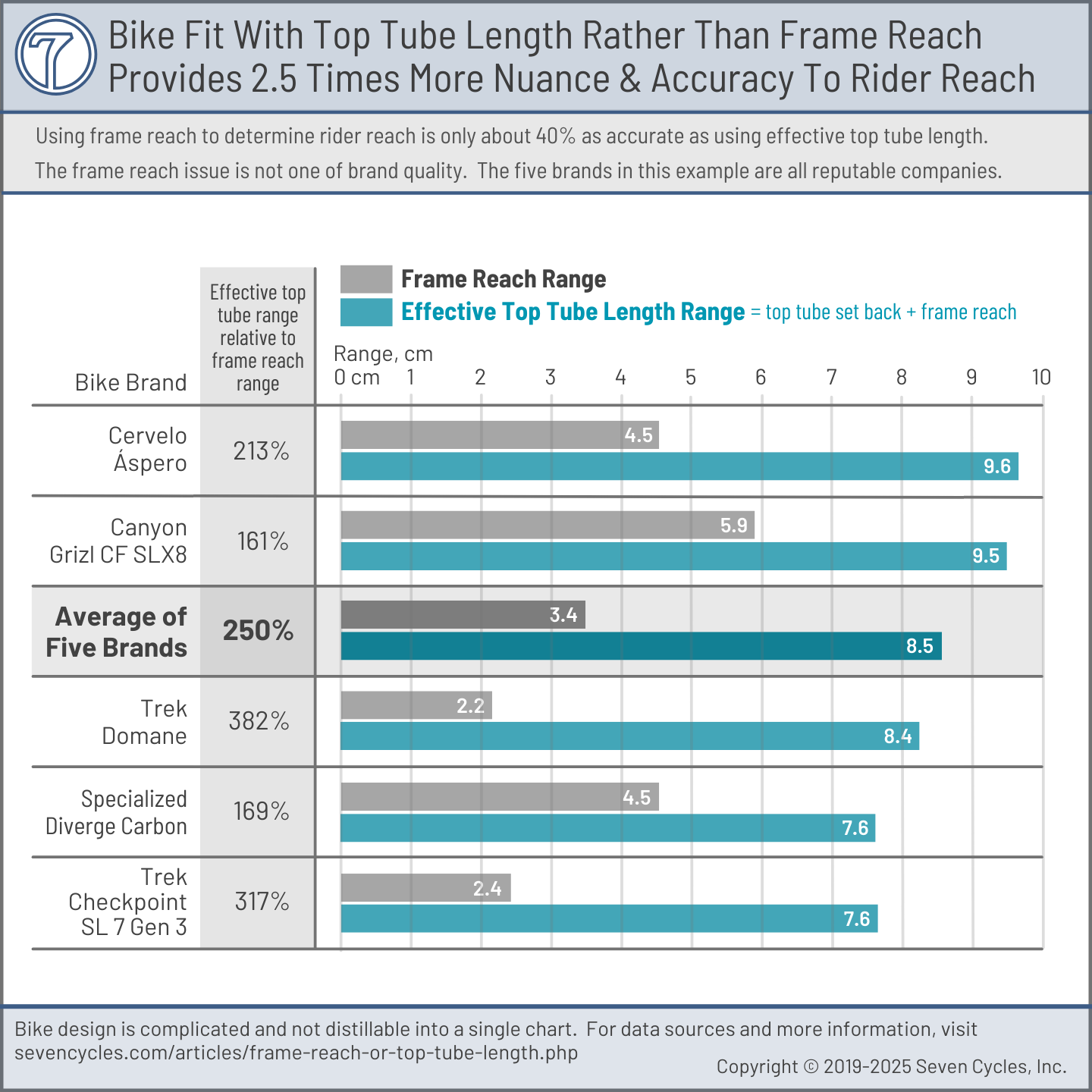Bike Fit: Frame Reach Is Not An Effective Measure For Determining Rider Fit
Overview: Frame reach correlates very little to rider fit on drop-bar bikes and is not useful as a stock bike sizing measurement. Conversely, effective top tube length provides the best starting point for delivering proper fit on stock bikes. As a fitting tool, top tube provides twelve times more accurate rider fit than frame reach data.
Bike fitting can be complicated. However, when fitting riders to stock bikes, only a few geometric measurements account for more than 90% of the frameset's fit appropriateness.
When fitting a rider to a preexisting bike, three frameset measurements dominate the conversation:
- Frame stack
- Frame reach
- Effective top tube length
Figure 1 illustrates how these measurements relate to the bike.
Only two of these measurements have value for bike fit: Effective top tube length and frame stack. Figure 2 shows, in a simple diagram, how pointless frame reach generally is. Figure 3 provides ten top gravel bike examples to show in detail why frame reach is essentially meaningless and the cause of strife when ordering a stock bike.

Separately, components like stem, bar, saddle, seat post, cranks, and grips all have important influences on how a bike fits and handles. However, the farther from the designer's intended size that these components go, in order to properly fit a rider, the more problematic the rider's center of gravity, handling, performance, and safety become. Components are a topic for another day.
Why Trust Seven on This Topic?
Depth: Seven has designed and built more than 35,000 custom bikes. Seven has engineered the fits on over 25,000 of those bikes.
Palmeres: Seven's lead fitter has performed thousands of in-person fit consultations. He has been fitting riders for over three decades. He's built frames for Eddy Merckx, Lance Armstrong, John Tomac, and many other world champions, national champions, and Olympians.
Team: Seven has four professional fitters on staff with nearly six decades of combined fit experience.
No preference: We are agnostic regarding fit methodology. Fitters should use whatever methods work best for them to optimize rider performance, comfort, injury management, etc. If frame reach serves a purpose for some, that's fine.
We provide frame reach data, along with all standard frame geometry, for all of our Rider-Ready designs.
Figure 2 illustrates how little value frame reach offers. Two framesets: A Trek Domane SLR and a Trek Checkmate SLR. Both are premium bikes. Both have the same frame reach (38.6 and 38.5 cm respectively). The Domane is Trek's largest size. The Checkmate is their "small" frame (their second smallest size). The gap between frame stacks is 11.6 cm. No rider would look at both bikes as potential purchases even though the frame reaches are identical.
We used Trek for this example because they are a well-respected brand. The frame reach weirdness is not a shortcoming of their design. Every top supplier has the same situation. And, looking across brands, the situation is just as bleak.

Figure 2 notes:
Bottom bracket drop: To simplify this comparison, we've kept the bottom bracket drop identical on both bikes. However, accounting for that difference, the Domane's stack height would be 0.5 cm higher, making the discrepancy between the two bikes even worse to a 12.1 cm gap. (The Domane's drop is 7.5 cm. The Checkmate's drop is 8.0 cm.)
Head tube angles are also different on both bikes but this does not impact their respective frame reach measurements. However, this does affect rider fit slightly. The smaller frame's slacker head tube angle pushes back the stem center by about 2 mm. (The Domane's head tube angle is 72.1°. The Checkmate's is 71.3°.)
Figure 3 shows that frame reach has no useful relationship to frame stack and top tube length across ten top brands. The left-hand chart shows frame stack for a given frame reach (38.8 cm is a decent average reach) of the ten brands. The right-hand chart shows the frame stack cluster when using top tube length (54.5 cm in this case). The difference in clusters is stark. Fitting with top tube length provides a 1,200% rider fit improvement over using frame reach as a starting point.

Figure 3 notes:
Figure 3 combines two other figures. It is a combination of frame reach plus frame stack shown in Figure 4 and top tube length with frame stack shown in Figure 5.
Ten models: We measured ten bike models across seven reputable brands. The ten brands, models, and naming abbreviations are shown below.
12x more accurate: How does Seven arrive at that calculation? As shown in Figure 3:
Frame reach in the left-hand chart: Holding frame reach as the constant results in an 8 cm grid for top tube length range and a 12 cm grid of frame stack range. 8 x 12 = a 96 cm grid.
Effective top tube length in the right-hand chart: Using top tube as the constant results in a grid of 2 cm of top tube length range and 4 cm of frame stack range. 2 x 4 = a 8 cm rectangle.
96 cm divided by 8 cm = 12 equates to a twelve times broader disbursement when using frame reach as a target measurement.
Area of reasonable fit: The shaded oval representation of reasonable fit is defined by plus or minus 1 cm of top tube length and plus or minus 2 cm of frame stack. Most fitters would likely agree that this is about as precise as can be expected when working with stock bikes. The oval is rotated clockwise by about 30 degrees because as the top tube gets longer than ideal, the frame stack should get taller, all things equal.
All geometry data is sourced directly from each brand's website.
If Seven is agnostic about fit, why are we even discussing frame reach?
Seven has seen the use of frame reach cause countless fit issues over the two decades that frame reach has been part of fitter language. We have never seen it solve drop-bar bike problems. It only adds to confusion and obfuscation regarding rider fit on stock bikes.
Unless you are a full-time fitter, using reach as a measure is a bad idea. Most riders don't understand the significant limitations of applying frame reach and how saddle type, position, height, setback, etc. all impact overall rider reach.
We think the fundamental confusion begins with using "reach" as a descriptive term. The measurement has little to do with the rider's actual reach from saddle to grips. For example, the radius of a wheel has about as much to do with fit as frame reach does; the impact on fit is not zero, but it's not of primary concern. Treating it as one of two primaries (the ever-popular "stack and reach") yields poor results.
We have never found a reason to use frame reach as a primary fit measurement on any drop-bar bike. For example, sometimes, in defense of frame reach, fitters claim that frame reach is better for fitting than seat tube length. That's a weird argument; that's fit theory from the 1970s. Seven knows of no fitter that uses seat tube length to discern rider position.
Visualizing Frame Stack and Reach
Figure 3 above shows how much more useful top tube length is relative to frame reach as a fitting measure. Frame reach has no discernable or consistent relationship to frame stack or top tube length.
Figure 4 illustrates what happens when a fitter chooses frame reach as the primary fit decider. It's clear (when compared to Figure 5 and Figure 6) that frame reach doesn't have much to do with the overall size of the frame. In the examples provided, ten of the most popular gravel bikes, for a 38.8 frame reach target (somewhat average reach), have top tube lengths that vary from 53 cm to 59 cm. Top tube length range is more than 6 cm. More concerning are frame stacks that range from about 54 cm to more than 65 cm. Frame stacks range by more than 11 cm. There is no way to properly fit a rider when using frame reach as the primary or first fit metric.
Figure 5 shows frame stack as the primary fit decider. This narrows the range by nearly 90%. With a target stack of 56 cm (about average), the total top tube length range is 4 cm with a stack range of less than 2 cm. That, for stock bikes, is a pretty workable range to choose from.
Figure 6 chooses effective top tube length as the primary fit determiner. In this example, we use an average 54.5 cm effective top tube length. This narrows the variation by another 40%, to 1 cm of top tube length variation and 5 cm of stack height. That's about as good as you'll get with any ten stock bike choices.



Translating Frame Reach To Rider Reach Is Inaccurate And Marginal
Figure 7 illustrates one of frame reach's shortcomings as a measurement. The frame reach range from smallest frame to largest frame for any single model offering is, on average, only about 40% of the range that effective top tube length does.
Fitting riders from about 5' to 6' 6" using an average reach range of only 3.4 cm, or 1.9 mm of reach per 1" of rider height, is problematic. That's like using a physical map of the U.S. and a ruler to determine the distance from Bayocean to Helen. One might think the distance and elevation gain become known, but it won't be very accurate. Instead, one could use the online map equivalent for rider fit: Effective top tube length. In either case, the map and the terrain are not the same.

The Ten Brands & Models
These brands and models are among the most popular gravel bike offerings in the States. These are all reputable brands. We do not intend to disparage these brands by having them represent the state of the stock bike industry.
We update this list periodically. Some of these models and frame data may be out of date. That doesn't really matter; the stark difference between frame reach and top tube length as fit metrics remains true year after year.
| Abbreviation | Brand | Model |
|---|---|---|
| ct | Cannondale | Topstone |
| cg | Canyon | Grizl CF SLX8 |
| ca | Cervelo | Áspero |
| ou | Open | UP |
| pg | Pinarello | Grevil |
| sc | Specialized | Crux Pro |
| sd | Specialized | Diverge Carbon |
| td | Trek | Domane SLR 9 Gen 4 |
| tcm | Trek | Checkmate SLR 9 |
| tcp | Trek | Checkpoint SL 7 Gen 3 |
